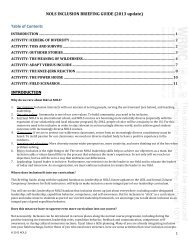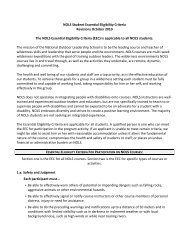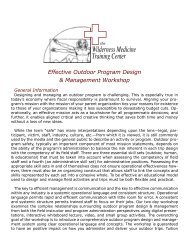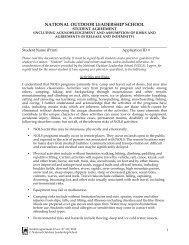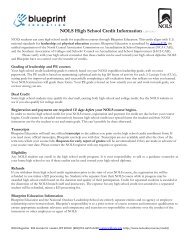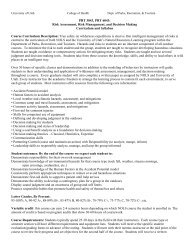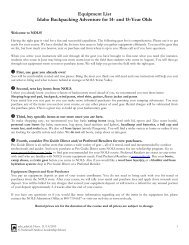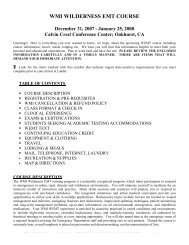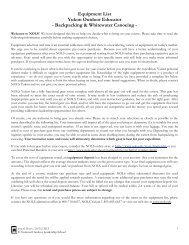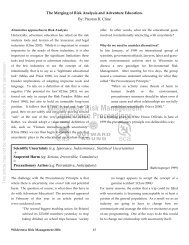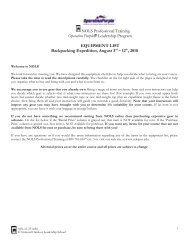introduction to the 2008 nols leadership educator notebook
introduction to the 2008 nols leadership educator notebook
introduction to the 2008 nols leadership educator notebook
Create successful ePaper yourself
Turn your PDF publications into a flip-book with our unique Google optimized e-Paper software.
comfort. Overall, <strong>the</strong> atmosphere is supportive, energetic and open.The <strong>leadership</strong> norm is peers guiding and coaching <strong>the</strong>ir peers.But beware: Stewardship takes lots of effort on <strong>the</strong> part of <strong>the</strong>instruc<strong>to</strong>rs and <strong>the</strong> group. Some people may not buy in<strong>to</strong> it. In<strong>the</strong> time span of a regular course, it is not likely <strong>to</strong> work perfectly,particularly if <strong>the</strong>re is a wide range of maturity levels in <strong>the</strong> group. Itcan be held as a vision more than something we believe we can arriveat easily. Most courses use large aspects of this model and semestersare able <strong>to</strong> take it fur<strong>the</strong>r still, often with excellent results.Peer expeditions have tried this model with various degrees ofsuccess. It works well in easy times and with well-bonded, maturegroups, less well in stressful times if <strong>the</strong> group doesn’t take <strong>the</strong> time<strong>to</strong> collaborate. Collaboration means taking time <strong>to</strong> discuss all <strong>the</strong>pros and cons and listen <strong>to</strong> o<strong>the</strong>r viewpoints. People venture in<strong>to</strong>trips or situations thinking <strong>the</strong>y are using this model, when actually<strong>the</strong>y have entered in<strong>to</strong> <strong>leadership</strong> abdication and laissez-faire, or, allpeople aren’t speaking up honestly and so only a few are actuallyrunning <strong>the</strong> expedition.DIMENSIONS OF LEADERSHIPAll leaders exhibit some of <strong>the</strong> behaviors encompassed in <strong>the</strong>sefour dimensions:• Being Au<strong>the</strong>ntic• Respecting• Conceptualizing• DirectingBreaking down <strong>leadership</strong> behavior in<strong>to</strong> <strong>the</strong>se four categoriesmay help you coach a student who is performing better in someareas than o<strong>the</strong>rs.Being Au<strong>the</strong>ntic occurs when you share what is going on foryou—in <strong>the</strong> moment—as it pertains <strong>to</strong> your current experience in<strong>the</strong> group. This is <strong>leadership</strong> through being open and honest aboutwhat you think, feel and want.Examples:1) “I am really frustrated that people keep carrying on side conversationsduring our classes.”2) fnigle“I’m frustrated that only two of <strong>the</strong> five members of thishiking group are reading <strong>the</strong> map. I want <strong>to</strong> hear input fromeveryone.”Too much or <strong>to</strong>o little “au<strong>the</strong>nticity”:• If I hide who I am and what I believe, <strong>the</strong>n people around memiss much of what I have <strong>to</strong> offer.• If I am so ‘loud’ with my beliefs and personal presence it leaveslittle room for o<strong>the</strong>rs <strong>to</strong> share <strong>the</strong>ir <strong>leadership</strong>.• I am most effective when I share who I am and what I believewhile still leaving room for o<strong>the</strong>rs <strong>to</strong> express <strong>the</strong>mselves.Group Outcomehighmediumlowlow medium highdegree of AUTHENTICbehavior expressedCoaching on Au<strong>the</strong>nticityUse direct feedback with specific examples of when you have seen<strong>the</strong> student be au<strong>the</strong>ntic or inau<strong>the</strong>ntic with o<strong>the</strong>rs.Discuss self-<strong>leadership</strong> and self-awareness as ways of working on<strong>leadership</strong>, even one is not in an LOD role.Respecting is just like it sounds. It occurs when you offer friendship,affection, support, praise and encouragement. Respectful leadersexpress warmth, acceptance, genuineness and a real concern forus. Respecting is about caring and supporting. This isn’t limited <strong>to</strong>being “warm and fuzzy”—genuine respecting can be conveyed ina “<strong>to</strong>ugh love” style. Simply put, this is <strong>leadership</strong> through beingsupportive, treating o<strong>the</strong>rs with respect, and showing people youbelieve in <strong>the</strong>m.Example: “Alan, you seem down about your efforts as leader of<strong>the</strong> day. I want you <strong>to</strong> know that I respect your efforts. I trust in yourability <strong>to</strong> turn <strong>the</strong>se lessons in<strong>to</strong> future success.” In general <strong>the</strong> morerespecting is done by <strong>the</strong> leader, <strong>the</strong> better <strong>the</strong> group outcome.Group Outcomehighmediumlowlow medium highdegree of RESPECTINGbehavior expressedCoaching on RespectVisualize a leader or men<strong>to</strong>r who has had a positive impact on yourlife. Now ask yourself, “Did I feel respected by this individual?”Think of some different ways this person conveyed <strong>the</strong>ir respectfor you or for your potential, like trusting you <strong>to</strong> hear critical feedbackor letting you make a mistake and <strong>the</strong>n supporting your learning.Conceptualizing describes <strong>the</strong> skill of helping <strong>the</strong> group makesense of behaviors, group dynamics and events that effect <strong>the</strong> group.This includes knowing <strong>the</strong> how’s and why’s of individual and groupbehavior, and helping people understand <strong>the</strong>ir current situationfrom a new angle. Have you ever seen a leader who could help agroup see <strong>the</strong> “big picture” when <strong>the</strong>y are stuck? Such leaders helppeople reconstruct <strong>the</strong>ir understanding of what is going on. Perhaps<strong>the</strong>y pointed out that conflict is “normal” and expected during <strong>the</strong>s<strong>to</strong>rming phrase of group development. When done well, you canalmost see <strong>the</strong> light bulbs light up over people’s heads, <strong>the</strong> proverbial,“Oh, now I get it!” Conceptualizing helps people make senseout of <strong>the</strong>ir experiences.Example: “I’m noticing that <strong>the</strong> group keeps rehashing this sameissue in every evening meeting. Perhaps that is because we are allpeers and it isn’t clear who should make this decision.”Coaching ConceptualizationOutline basic tasks so your students can understand <strong>the</strong> variousparts and how <strong>the</strong>y all fit <strong>to</strong>ge<strong>the</strong>r.Explain why <strong>the</strong> safety rules exist. Help students <strong>to</strong> create genericparameters for applying <strong>the</strong> concepts <strong>to</strong> o<strong>the</strong>r wilderness situations.Coach students on subtle improvements, leading <strong>the</strong>m <strong>to</strong> a deeperunderstanding of <strong>leadership</strong> skills and behaviors.Defining Leadership 14<strong>2008</strong> NOLS Leadership Educa<strong>to</strong>r Notebook




